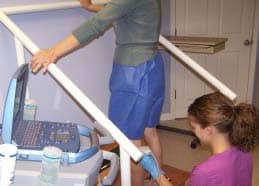
There are many reasons that a physician may have to want to see the veins throughout your body. For instance, he or she may want to view blood clots, called deep vein thrombosis, which can be a potentially deadly condition. It can also be used to diagnose any circulatory issues.
Using non-invasive vein mapping with ultrasound can locate these clots, as well as determine the cause of swelling that is commonly caused by varicose veins. The technique can also help guide the physician during procedures such as sclerotherapy.
Ultrasonography was developed from sonar technology that uses sound waves to find underwater objects.
Using ultrasound is a non-invasive procedure, which means that it does not require the use of needles, radiation, dyes, or even anesthesia.
During an ultrasound vein-mapping procedure, high-frequency sound waves are transmitted into the tissues of the body. The resulting echoes are recorded into photographic or video images. These images of the tissue structures can be used to find blockages in the blood vessels. In addition to blockages, ultrasounds can provide images of narrowing vessels, tumors, or congenital malformations.
Vascular ultrasound, also called a duplex study, can be used to examine the circulation of the blood in the legs and arms. No needles, dyes, or radiation is required with this non-invasive procedure.
During this procedure, sound waves are transmitted through the tissues. These waves will bounce off of blood cells that are moving in the blood vessels, allowing the speed to be calculated.
The procedure itself is very simple and painless. A water-soluble gel will be applied to the exam area. Then a small device or transducer is placed over the area. This device will then produce images that will be seen on a screen.
While the procedure is painless, you may hear some noises as the doctor listens to the blood flow. The procedure will take between 30 to 90 minutes to complete.
After the procedure, the gel will be removed and you can go home or return to your normal schedule. There are no side effects to this procedure. Additionally, this ultrasound procedure does not use harmful radiation as X-rays do.
